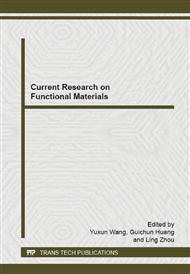[1]
Czech N,Fietzek H,Juez-Lorenzo M,et al. Studies of the bond-coat oxidation and phase structure of TBCs [J]. Surface Coating Technology, 1999, 113(1/2): 157-161.
DOI: 10.1016/s0257-8972(98)00835-4
Google Scholar
[2]
Yujuan Zhang, Yuchi Zhang et al. Recent research about thermal barrier coatings [J]. Materials Protection, 2004, 37(6): 263-265.
Google Scholar
[3]
Dongbai Xie, Fuhui Wang. History of thermal barrier coating and recent reseach[J]. Material Review, 2002, 16(3): 7-11.
Google Scholar
[4]
Hongming Zhou, Danqing Yi et al. Recent research of thermal barrier coating and development direction [J]. Materials Review, 2006, 20(3): 6-9.
Google Scholar
[5]
Yongchang An. Recent modified surface technology [J]. Foreign metal processing, 1990, 6(1): 30-32.
Google Scholar
[6]
Igor L. Pobol. Recent improvement of electric beam surface engineering (I) [J]. China device management, 2000, 6(8): 54-55.
Google Scholar
[7]
Hui Zou, Qinfeng Guan et al. Surface modification of 45# steel by high current pulsed electron beam[J], Journal of Jilin University, 2004, 34 (1), 12-16.
Google Scholar
[8]
Proskurovsky D I, Rotshtein V P, Ozur G E, et al. Pulsed electron-beam technology for surface modification of metallic materials [J]. American Vacuum Society, 1998, 16(4): 2483.
DOI: 10.1116/1.581369
Google Scholar
[9]
Hui Zhao, Yan Chen, et al. The effect of HCPEB treatment on W18Cr4V high-speed steel [J]. Metallic Thermal Processing, 2011, 5(36): 37-41.
Google Scholar
[10]
Ying Qin, Aimin Wu, Jianxin Zou et al. Physical model and numerical simulation of intense pulsed electron beam surface modification[J], Vacuum Science and Technology, 2003, 6 (15): 15-19.
Google Scholar
[11]
Schiller S,Heisig Μ,Panzer S. Electron Beam Technology[M]. AWiley Intersciece Publication, 1982. 16(4): 29-42.
Google Scholar
[12]
Zhiyong Han, Hua Zhang, Zhiping Wang. Roman testing and numerical analysis about the residual stress of thermal barrier coatings [J]. China Journal of Aeronautics. 2012, 32(2): 11-14.
Google Scholar
[13]
Zhenfei Song, Ying Qin et al. Numerical simulation of HCPEB on thermal barrier coatings[J]. Vacuum Science and Technology. 2008, 5 (28): 11-12.
Google Scholar
[14]
Zhenmin Liu, Shengzhi Hao et al. Post-treatment of Ti-implanted 9Cr18 steel using pulsed high current electron beam[J]. Nuclear Technology, 2000, 23 (7) : 447-451.
Google Scholar
[15]
Jianxin Zou. Fundamental research of surface modification using high current pulsed electron beam[D]. Dalian, Dallian University of Technology, (2007).
Google Scholar


